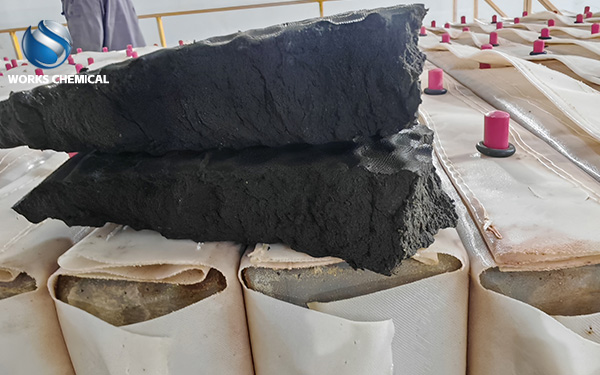
The selection of an appropriate sludge conditioner (sludge enhancer) requires a comprehensive consideration of multiple factors such as sludge properties, treatment processes, cost-effectiveness, and environmental protection requirements. The following are the specific selection strategies:

First, clarify the nature of the sludge and precisely match the type of conditioning agent
Organic content-dominated sludge
Typical scenario: Excess sludge from urban sewage treatment plants (with high organic matter content, strong hydrophilicity, and fine particles).
Recommended conditioner: cationic organic polymer conditioner (such as cationic polyacrylamide CPAM).
Mechanism of action: By neutralizing the negative charges on the surface of sludge particles with positive charges, compressing the double electric layer, and forming large flocs through molecular chain bridging, the moisture content can be significantly reduced (down to below 60%).
Inorganic material-dominated sludge
Typical scenario: Metal hydroxide sludge produced from industrial wastewater treatment (with large particles and weak hydrophilicity).
Recommended conditioning agents: inorganic conditioning agents (such as iron salts, aluminum salts) or anionic organic polymer conditioning agents.
Mechanism of action: Iron salts (such as polyferric chloride) hydrolyze to form Fe(OH)₃ flocs and coagulate into particles. Aluminum salts (such as polyaluminium chloride) achieve electro-neutralization through polynuclear hydroxyl complexes.
Sludge with complex properties
Oily sludge: First, demulsification is carried out (such as by adding demulsifiers), and then inorganic conditioning agents (such as ferric chloride) and cationic CPAM are compounded to form flocs that encapsulate oil droplets.
High-microbial activated sludge: Add an appropriate amount of biocides to inhibit microbial metabolism, and then supplement with conventional organic high-molecular conditioning agents.
Refractory organic sludge: Polymers containing sulfonic acid groups, hydroxyl groups and other functional groups are selected to enhance the dewatering performance through chemical reactions.
Typical scenarios: oily sludge, sludge with high microbial activity or sludge containing refractory organic matter.
Recommended plan:
Second, optimize the selection of conditioning agents in combination with the treatment process
Mechanical dewatering processes (such as plate and frame filter presses, centrifuges)
Plate and frame filter press: Inorganic conditioners (such as iron salts) or compound conditioners (such as iron salts +CPAM) form dense flocs, which are conducive to high-pressure dewatering.
Centrifugal dewatering: Organic polymer conditioning agents (such as CPAM), their large flocs are easy to separate under centrifugal force.
Recommended conditioner:
Natural drying process
Recommended conditioning agents: acid-base conditioning agents (such as lime) or biological conditioning agents, which accelerate drying by adjusting the pH value or microbial activity.
Third, weigh the cost and benefit and choose an economical plan
Pharmaceutical cost
Inorganic conditioning agents: They have low costs, but the dosage is large (5%-20% of the dry weight of sludge), which may increase the subsequent disposal costs.
Organic conditioning agent: The dosage is small (0.1%-0.5% of the dry weight of sludge), but the unit price is high. The optimal dosage needs to be determined through small-scale tests.
Compound conditioning agent: It reduces the total dosage through a synergistic effect (saving 20%-40% of the agent cost), while increasing the dehydration rate (up to 93.8%).
Operating cost
Filter cloth maintenance: The problem of organic conditioner sticking to the filter cloth can be alleviated by optimizing the preparation concentration (0.05%-0.1%) and the addition sequence (inorganic first, then organic).
Energy consumption: High-efficiency conditioning agents can shorten the pressing time (for example, in a certain case, when the sludge feed volume increases by 20%-30%, the pressing time is reduced), and lower the electricity bill.
Fourth, pay attention to environmental protection and promote resource utilization
Risk of secondary pollution
Avoid lime and iron salts: Strongly alkaline filtrate is prone to volatilization and odor, and increases the total amount of sludge, which is not conducive to incineration or composting.
Recommended eco-friendly conditioners: such as new organic high-molecular polymers (like PAA), neutral and environmentally friendly. The mud cakes can be used for brick-making or incineration.
Resource utilization potential
Low moisture content mud cake: Through deep dewatering (moisture content reduced to below 40%), it can be directly used in building materials utilization (such as brick-making) or incineration for power generation.
V. Through experimental optimization, determine the best plan
Steps of the small-scale experiment
Gradient dosing: Add the diluted conditioner in a gradient based on the solid content of the sludge (for example, after diluting 5 times, add 0.5, 1, and 1.5ml per 100 mL of sludge).
Performance evaluation: Record the vacuum-breaking time (simulating the filtration speed), and measure the moisture content of the mud cake (for example, in a certain case, the moisture content dropped to 38.2%).
Cost accounting: Based on the comprehensive expenses of chemicals, sludge reduction and disposal fees, electricity costs, labor costs, etc., calculate the annual cost savings (for example, in a certain case, 1.34 million yuan was saved annually).
Adjustment of key parameters
Addition sequence: Inorganic first and then organic to enhance the strength of flocs.
Mixing conditions: Ensure thorough mixing (such as stirring for 2 minutes) to prevent the destruction of flocs.
Environmental factors: When the temperature is low, extend the conditioning time or select agents with strong low-temperature adaptability. Change the type of conditioner when the pH value deviates from the optimal range.
Summary
The selection of sludge conditioning agents should follow the principles of "property matching, process adaptation, cost control, and environmental protection priority". Through small-scale experiments, the optimal types of chemicals, dosages and operating conditions can be determined, which can significantly improve the dewatering efficiency (reduce the moisture content by 10%-30%), lower the treatment cost (annual cost savings can reach the level of millions of yuan), and promote the resource utilization of sludge.